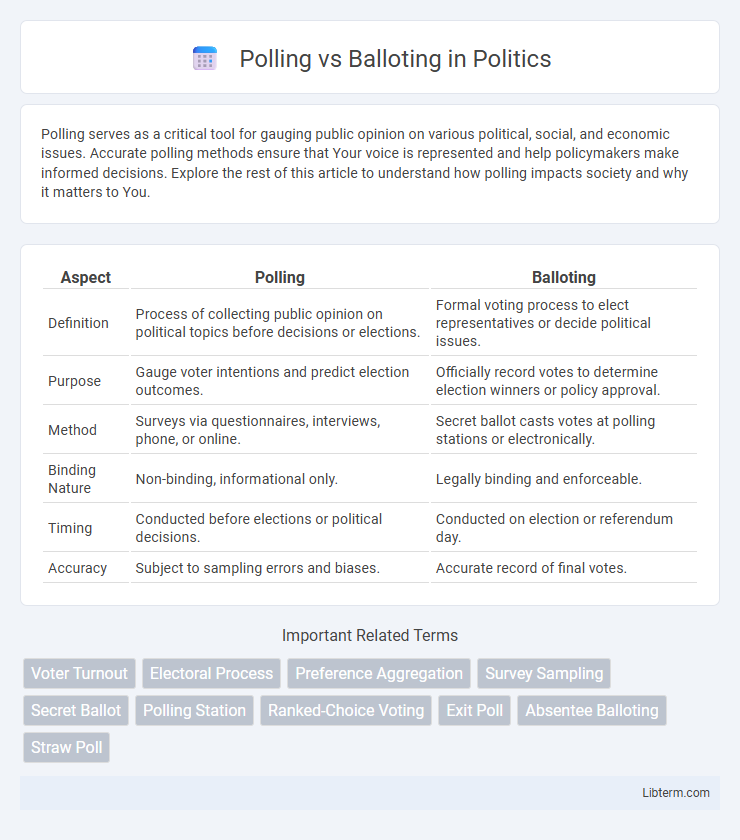Polling serves as a critical tool for gauging public opinion on various political, social, and economic issues. Accurate polling methods ensure that Your voice is represented and help policymakers make informed decisions. Explore the rest of this article to understand how polling impacts society and why it matters to You.
Table of Comparison
| Aspect | Polling | Balloting |
|---|---|---|
| Definition | Process of collecting public opinion on political topics before decisions or elections. | Formal voting process to elect representatives or decide political issues. |
| Purpose | Gauge voter intentions and predict election outcomes. | Officially record votes to determine election winners or policy approval. |
| Method | Surveys via questionnaires, interviews, phone, or online. | Secret ballot casts votes at polling stations or electronically. |
| Binding Nature | Non-binding, informational only. | Legally binding and enforceable. |
| Timing | Conducted before elections or political decisions. | Conducted on election or referendum day. |
| Accuracy | Subject to sampling errors and biases. | Accurate record of final votes. |
Introduction to Polling and Balloting
Polling involves systematically collecting opinions or votes from a group to gauge preferences or make decisions, often used in elections or surveys. Balloting refers specifically to the process of casting and counting votes in a formal election, ensuring confidentiality and accuracy. Both methods serve crucial roles in democratic decision-making, with polling providing preliminary insights and balloting delivering final, official results.
Defining Polling: Purpose and Methods
Polling involves systematically collecting opinions or data from a targeted group to gauge public sentiment or preferences, often used in political, market research, or social studies. Methods of polling include face-to-face interviews, telephone surveys, online questionnaires, and exit polls, each designed to ensure representative sampling and accurate data collection. The primary purpose of polling is to predict outcomes, understand trends, and inform decision-making processes based on statistical analysis of gathered responses.
Understanding Balloting: Process and Types
Balloting refers to the structured process of casting and counting votes during elections or decision-making events, ensuring voter anonymity and accuracy. The primary types of balloting include paper ballots, electronic ballots, and mail-in ballots, each offering distinct advantages in accessibility and security. Understanding the balloting procedure involves recognizing its stages: voter verification, ballot distribution, vote casting, and ballot counting, which are critical to maintaining election integrity.
Key Differences Between Polling and Balloting
Polling involves collecting opinions or votes from a sample audience, emphasizing measurement of preferences or choices, while balloting refers specifically to the formal process of casting and counting votes in an election. Polling typically gathers data through surveys or questionnaires before an event to predict outcomes, whereas balloting is the official mechanism ensuring actual vote recording and determining results. The key difference lies in polling being a predictive tool and balloting serving as the definitive decision-making procedure.
Advantages of Polling in Decision Making
Polling enables rapid collection of opinions from a large group, facilitating timely and informed decision-making. It provides quantifiable data that helps identify majority preferences and trends, enhancing transparency and fairness in the process. The simplicity and flexibility of polling make it ideal for gauging public sentiment or employee feedback with minimal resource expenditure.
Benefits of Balloting for Secure Voting
Balloting offers enhanced voter anonymity by using secret ballots, which prevents voter coercion and ensures privacy during elections. It provides a transparent and auditable record that helps verify election results accurately, minimizing the risk of fraud. This secure voting method fosters greater trust and confidence among participants by protecting the integrity of the electoral process.
Common Uses: When to Poll and When to Ballot
Polling is commonly used in situations requiring quick feedback or informal consensus, such as during meetings or online surveys, due to its simplicity and speed. Balloting is preferred in formal decision-making processes like elections or legislative votes where confidentiality and accuracy are crucial, often involving secret ballots to ensure unbiased results. Organizations typically choose polling for gauging opinions on non-binding issues, while balloting is reserved for binding decisions requiring verified validation.
Technological Advancements in Polling and Balloting
Technological advancements in polling and balloting have revolutionized voter accessibility and election accuracy through the integration of electronic voting machines, secure online platforms, and biometric verification systems. These innovations minimize human error and streamline vote counting, enhancing election transparency and reducing fraud risks. Blockchain technology and AI-driven analytics further optimize security protocols and real-time result reporting, setting new standards in electoral process efficiency.
Challenges and Limitations of Each Method
Polling methods face challenges such as sample bias, limited response accuracy, and difficulties ensuring representative data, often resulting in skewed or unreliable insights. Balloting systems encounter limitations including logistical complexities, risks of voter fraud, and accessibility barriers, which can undermine the fairness and inclusiveness of elections. Both methods struggle with ensuring transparency and trust while maintaining efficiency in data collection and decision-making processes.
Choosing the Right Approach: Polling vs Balloting
Choosing the right approach between polling and balloting depends on the decision's nature and required confidentiality. Polling suits quick, informal feedback with transparent results, while balloting ensures anonymity and accuracy in formal elections or sensitive decisions. Evaluating factors like participant size, privacy needs, and result transparency optimizes the effectiveness of either method.
Polling Infographic

 libterm.com
libterm.com